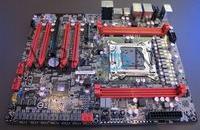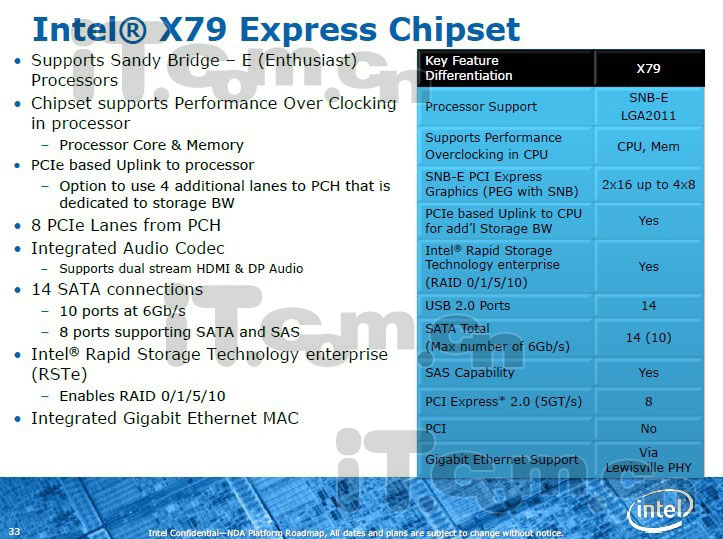Frequencies and three caches Sandy Bridge-E models have appeared on the Web. The Core i7-3960X is a six processor cores running at 3.30 GHz and 3.9 GHz up to Turbo mode. It has a 15 MB L3 cache is expected to be the most expensive of all and probably cost about $ 1 000. The Core i7-3930K will have the same number of cores, but lower frequencies.
It will run at 3.20 GHz and 3.80 GHz normal mode Turbo mode. It has 12 MB of L3 cache. The last is a quad core processor by the name of Core i7-3810. It will run at 3.60 GHz and have a turbo 3.9-GHz and 10 MB L3 cache. This information from the site Donanim Haber and if proven correct, would mean first that Intel has decided to change the nomenclature to describe Sandy Bridge-E with the number three at the top of each model.
We remember that he had introduced a four-digit nomenclature with Sandy Bridge that are designated as ix-Core 2xxx when they are not broken down version of Pentium or Celeron. The idea of a change in nomenclature for Sandy Bridge-E was issued in June, but at the time, we talked about using the name Core i8.
Intel have decided to appoint Sandy Bridge-E as a new architecture, which is not entirely accurate. The Sandy Bridge-E are primarily Sandy Bridge requiring a high-end Socket LGA 2011. Moreover, according to the latest information published on VR-Zone, Intel lowered count the characteristics of x79 motherboards in order to get his product before the end of the year.
Earlier this month, rumors claimed that Sandy Bridge-E were delayed and had to go out at CES 2012 (see "The Sandy Bridge E-postponed to early 2012"). The reasons for the delay were unknown. Today, the sounds of corridors say that Intel would experience problems with the x79 chipset that meets the code name X-Patsburg and was to be similar to the chipset Patsburg-D with some modifications to the mass market.
The Patsburg D is the high-end chipset for Xeon-E Sandy Bridge. It has eight SAS ports - SATA 6 Gb / s and uses a link 4x PCI-Express 3.0 port to connect the CPU and SAS to optimize performance storage solutions. In response to its development problems and his desire to leave the Sandy Bridge-E before the end of the year, the x79 should be downgraded to a B-Patsburg that manages only four SAS ports - SATA 6Gb / s.
The PCI-Express 3.0 would also be abandoned. If this information is correct, this means that the platform Sandy Bridge-E would lose some of its appeal. These changes have no impact on performance in general, but the life of the platform could be reduced, which is more harmful in this high-end system that is supposed to last until the second half of 2013.
These last minute changes also require us to ask whether the integration of Sandy Bridge-E in the family of Core-3xxx ix expected to be mostly populated by Ivy Bridge is sound. This decision is most likely to confuse the consumer while the new architecture, which is scheduled to arrive in the second quarter 2012 will support PCI-Express 3.0.
Meanwhile, the three processors shown on the run all support HyperThreading and all have a TDP of 130 W. The X is an Extreme Edition model and the K points to an unlocked multiplier. This information corroborates the rumors that we report last May (see "No increase in frequency for the Sandy Bridge-E").
Intel frequencies remain cautious, but these processors are designed to integrate high-end configurations, Intel expects that consumers probably overclockent their own processor.



It will run at 3.20 GHz and 3.80 GHz normal mode Turbo mode. It has 12 MB of L3 cache. The last is a quad core processor by the name of Core i7-3810. It will run at 3.60 GHz and have a turbo 3.9-GHz and 10 MB L3 cache. This information from the site Donanim Haber and if proven correct, would mean first that Intel has decided to change the nomenclature to describe Sandy Bridge-E with the number three at the top of each model.
We remember that he had introduced a four-digit nomenclature with Sandy Bridge that are designated as ix-Core 2xxx when they are not broken down version of Pentium or Celeron. The idea of a change in nomenclature for Sandy Bridge-E was issued in June, but at the time, we talked about using the name Core i8.
Intel have decided to appoint Sandy Bridge-E as a new architecture, which is not entirely accurate. The Sandy Bridge-E are primarily Sandy Bridge requiring a high-end Socket LGA 2011. Moreover, according to the latest information published on VR-Zone, Intel lowered count the characteristics of x79 motherboards in order to get his product before the end of the year.
Earlier this month, rumors claimed that Sandy Bridge-E were delayed and had to go out at CES 2012 (see "The Sandy Bridge E-postponed to early 2012"). The reasons for the delay were unknown. Today, the sounds of corridors say that Intel would experience problems with the x79 chipset that meets the code name X-Patsburg and was to be similar to the chipset Patsburg-D with some modifications to the mass market.
The Patsburg D is the high-end chipset for Xeon-E Sandy Bridge. It has eight SAS ports - SATA 6 Gb / s and uses a link 4x PCI-Express 3.0 port to connect the CPU and SAS to optimize performance storage solutions. In response to its development problems and his desire to leave the Sandy Bridge-E before the end of the year, the x79 should be downgraded to a B-Patsburg that manages only four SAS ports - SATA 6Gb / s.
The PCI-Express 3.0 would also be abandoned. If this information is correct, this means that the platform Sandy Bridge-E would lose some of its appeal. These changes have no impact on performance in general, but the life of the platform could be reduced, which is more harmful in this high-end system that is supposed to last until the second half of 2013.
These last minute changes also require us to ask whether the integration of Sandy Bridge-E in the family of Core-3xxx ix expected to be mostly populated by Ivy Bridge is sound. This decision is most likely to confuse the consumer while the new architecture, which is scheduled to arrive in the second quarter 2012 will support PCI-Express 3.0.
Meanwhile, the three processors shown on the run all support HyperThreading and all have a TDP of 130 W. The X is an Extreme Edition model and the K points to an unlocked multiplier. This information corroborates the rumors that we report last May (see "No increase in frequency for the Sandy Bridge-E").
Intel frequencies remain cautious, but these processors are designed to integrate high-end configurations, Intel expects that consumers probably overclockent their own processor.



- Bulldozer prototype suggests AMD shooting for Sandy Bridge performance (13/07/2011)
- AMD Bulldozer prototype gets benchmarked, could give Sandy Bridge some competition (15/07/2011)
- Hot Tech Deals - Antec Continuous Power Supply for $34.99 + more (18/07/2011)
- Hot Tech Deals - Dell Discounts + more (10/07/2011)
- Gear Deal: Dell Inspiron 15R W/2nd Gen "Sandy Bridge" Laptop, Switchable Lids and Blu-ray (07/07/2011)
No comments:
Post a Comment